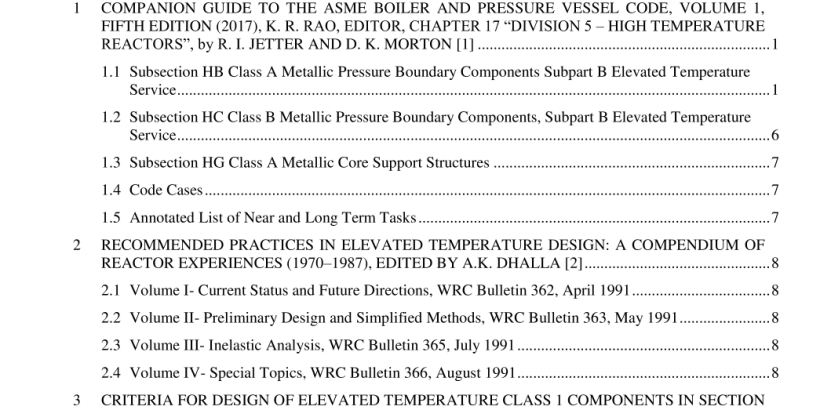ASME NTB-2-2019 pdf free download.Background Information for Addressing Adequacy or Optimization of ASME BPVC Section III, Division 5 Rules for Metallic Components
The discussion in Section 2.0 Elevated Temperature Material Behavior of the Criteria for Design is still relevant and has been carried forward, in whole or in part, in subsequent documents. Of particular interest is the discussion of isochronous stress-strain curves (ISSC).
There is a general discussion of the generation of ISSC in Appendix A of the Criteria for Design and a more detailed discussion in the ASME publication, The Generation of Isochronous Stress-Strain Curves [13]. The ISSC are used for negligible creep criteria in HBB-T-1324 “Test A-3”, strain limits using simplified inelastic analysis in HBB-T-1430, creep-fatigue limits using elastic analysis in HBB-T-1430, and, in particular, evaluation of creep damage based on ISSC in HBB-T-1433(a) Step 5(b), which is a frequently used conservative procedure. Also, it should be noted that the creep parameters shown in Figure 3 of the Criteria for Design are misleading and have been corrected in Figure 17.3 of the Fifth edition of the Companion Guide.
The structural failure modes identified in Section 3.0 are the same as those in HBB-1110(e) and (f), however, aging effects are now covered in HBB-2160 Deterioration of Materials in Service. Section 4.0 Stress and Strain Categories and Controlled Quantities is still applicable. Figure 7 corresponds to Figure HBB-3221-1. Section 5.0 Design Rules for Load-Controlled Stresses in Structures other than Bolts is still generally applicable. Section 5.1 on Design Conditions is related to HBB-3222.1.
The criteria for determining the time dependent allowable stress values for S t based on creep-rupture strength, accumulated strain and on- set of third stage creep are identified in Section 5.2. These criteria are in HBB-3221(b) except that the criteria on stress to produce 1% strain in HBB-3221(b) is based on the average stress not the minimum stress.
The discussion in Section 5.3 relates to the allowable stress levels for different loading conditions as shown in HBB-3222.2, HBB-3223, HBB-3224, and HBB-3225, however, the terminology has changed and Normal, Upset, Emergency, and Faulted have been replaced by Level A, B, C and D Service Loadings, respectively, corresponding to a general change in terminology in Section III. The background for loading involving bending is in Section 5.4 and corresponds to the criteria shown in HBB-3222.2, HBB-3223, HBB-3224, and HBB-3225. The use-fraction discussion in Section 5.5 corresponds to the limits of HBB-3224, which also include HBB-2222 and HBB-2223. The current version of Division 5 also has additional Service Level D criteria based on the strength of weldments as discussed in Section 2.1 of this background document under HBB-3221 which references Section 17.4.4.5.2 of the Companion Guide. Section 6.0 Design Rules and Limits on Strain for Structural Integrity is still relevant, however, based on additional analytical studies, additional limits have been identified as discussed above in Section 2.1 of this background document under HBB-T-1330 which references Section 17.4.4.3.6.3 of the Companion Guide. The discussion in Section 6.4.1 applies to the rules in HBB-T-1321, HBB-T-1322 and HBB-T-1323. The discussion in Section 6.4.2 applies to the rules in HBB-T-1330 except for the noted additional limits. Based on additional analyses the geometry restrictions on the applicability of the O’Donnell-Porowsky methodology [14] discussed in Section 6.4.2 have also been somewhat relaxed in HBB-T-1331(a) to structures in which the peak stress is negligible. The discussion on cycle definition in Section 6.4.3 is still generally applicable.
A major portion of Section 7.0 Creep-Fatigue that is based on elastic analysis has been replaced by a different methodology as discussed above in Section 2.1 of this background document under HBB-T-1411, which references Section 17.4.4.3.7.1 of the Companion Guide, and under HBB-T-1430, which references Section 17.4.4.3.7.5 of the Companion Guide. The discussions in Section 7.1 and Section 7.2 are still generally relevant and apply to the overall approach in HBB-T-1400. The design curve methodology discussed in Section 7.3 has been replaced. That part of Section 7.4 on mean stress is still applicable, but provisions have been added in HBB-T-1411, HBB-T-1432 and HBB-T-1433 to address multiaxial effects. Section 7.5 on rotating principal strains is applicable to the rules in HBB-T-1413. ASME NTB-2 pdf download.ASME NTB-2-2019 pdf free download
